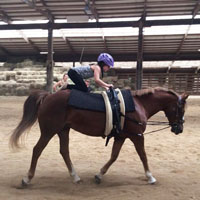
Kari makes her own gentle contact with the bit while moving in good cadence. She is been lunged with Lauffer reins.
Side-reins are probably the most commonly used lunging aid. They are great helpers to provide your horse with a solid stretching workout.
The advantage of sliding side-reins compared to solid side reins is the possibility for the horse to stretch long and low to loosen its neck and long back muscle. Instead of being held in a frame, the horse has an adjustable frame it can move its neck in and reach the position of self-carriage. In addition, the sliding side-reins provide more possibilities to adjust height, length, and frame of movement.
Sliding side reins are available as “Lauffer reins”, which are two separate reins, or as “Vienna reins”, which start as one rein and then split into two. Lauffer reins can also be attached as Vienna reins. The Lauffer reins provide the horse with a lateral restriction while the Vienna reins leave the possibility to turn the head to the side but restrict the movement up and downward.
Sliding side-reins attach to the girth, run along each side of the horse through the bit rings, and fasten back to the girth on the side or between the horse’s front legs. When starting, keep side-reins long, then shorten them if you need to. You want your horse to seek the contact, not being held or forced into a shape. The horse should be able to make contact with the bit when he carries his neck slightly arched, with his face at or marginally in front of the vertical. Early in training when working the horse long and low, the side-reins are attached to the middle and lower surcingle rings – at the height of the horse’s chest. At a later stage when you start working more in collection, they may be attached to the upper and middle rings.

The sliding side reins can also be adjusted to be used as Vienna reins. They start as one rein between the horses front legs and then split into two.
With half-halts, you encourage the horse to work into a contact, while the side-reins put pressure on the bit if the horse raises his head beyond a desired point. This acts on the corners of the mouth, encouraging the horse to lower its head to release the pressure. The horse needs to be working forward into the contact to be worked correctly long and low. You want to engage your horse’s hind legs to step under the center of gravity, make it stretch its back, and reach out and down with his head and neck. If the side reins are correctly adjusted, your horse will make its own gentle contact with the bit while moving with good balance.
Signs of Progression and a Pleasant Workout:
- Softly chewing the bit, which produces foam in the mouth.
- Showing more roundness in the back, stretching the neck, while continuing to reach forward with the hind legs under the center of gravity.
- A more steady, consistent, and loose head carriage – but not stiff or over-flexed.
- Relaxation and rhythm: indications are a rhythmically swinging tail, movement of the back and “butt muscles” and gently snorting or blowing through the nose.
- Developing self-carriage as a result of connecting well and giving to the side reins.


